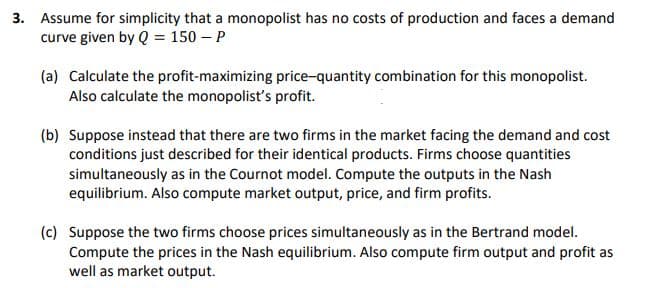3. Assume for simplicity that a monopolist has no costs of production and faces a demand curve given by Q = 150 – P (a) Calculate the profit-maximizing price-quantity combination for this monopolist. Also calculate the monopolisť's profit. (b) Suppose instead that there are two firms in the market facing the demand and cost conditions just described for their identical products. Firms choose quantities simultaneously as in the Cournot model. Compute the outputs in the Nash equilibrium. Also compute market output, price, and firm profits. (c) Suppose the two firms choose prices simultaneously as in the Bertrand model. Compute the prices in the Nash equilibrium. Also compute firm output and profit as well as market output.
3. Assume for simplicity that a monopolist has no costs of production and faces a demand curve given by Q = 150 – P (a) Calculate the profit-maximizing price-quantity combination for this monopolist. Also calculate the monopolisť's profit. (b) Suppose instead that there are two firms in the market facing the demand and cost conditions just described for their identical products. Firms choose quantities simultaneously as in the Cournot model. Compute the outputs in the Nash equilibrium. Also compute market output, price, and firm profits. (c) Suppose the two firms choose prices simultaneously as in the Bertrand model. Compute the prices in the Nash equilibrium. Also compute firm output and profit as well as market output.
Chapter15: Imperfect Competition
Section: Chapter Questions
Problem 15.1P
Related questions
Question

Transcribed Image Text:3. Assume for simplicity that a monopolist has no costs of production and faces a demand
curve given by Q = 150 – P
(a) Calculate the profit-maximizing price-quantity combination for this monopolist.
Also calculate the monopolisť's profit.
(b) Suppose instead that there are two firms in the market facing the demand and cost
conditions just described for their identical products. Firms choose quantities
simultaneously as in the Cournot model. Compute the outputs in the Nash
equilibrium. Also compute market output, price, and firm profits.
(c) Suppose the two firms choose prices simultaneously as in the Bertrand model.
Compute the prices in the Nash equilibrium. Also compute firm output and profit as
well as market output.
Expert Solution
This question has been solved!
Explore an expertly crafted, step-by-step solution for a thorough understanding of key concepts.
This is a popular solution!
Trending now
This is a popular solution!
Step by step
Solved in 5 steps with 4 images

Knowledge Booster
Learn more about
Need a deep-dive on the concept behind this application? Look no further. Learn more about this topic, economics and related others by exploring similar questions and additional content below.Recommended textbooks for you


Managerial Economics: Applications, Strategies an…
Economics
ISBN:
9781305506381
Author:
James R. McGuigan, R. Charles Moyer, Frederick H.deB. Harris
Publisher:
Cengage Learning



Managerial Economics: Applications, Strategies an…
Economics
ISBN:
9781305506381
Author:
James R. McGuigan, R. Charles Moyer, Frederick H.deB. Harris
Publisher:
Cengage Learning
